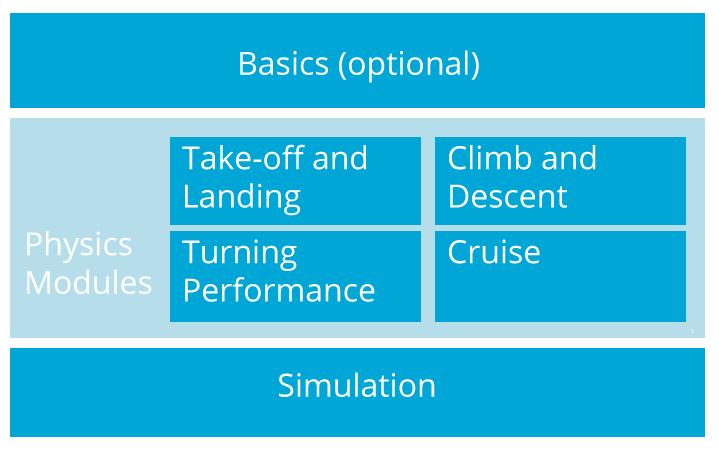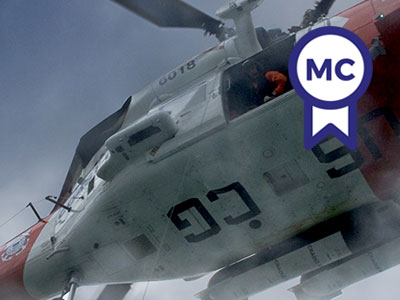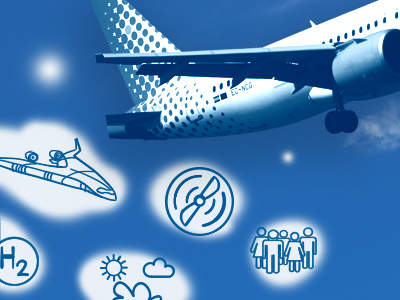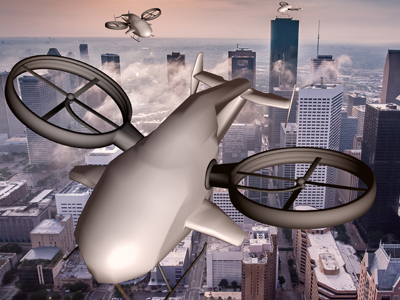Overview
Course video
This course offers you practical insights for real-world aircraft operations and development of future aircraft designs, by diving into the physics and phenomena that determine aircraft performance.
Aircraft performance is an exciting and challenging field that is continuously evolving. For example, by the year 2050, civil aircraft should have 75% less emissions than present day aircraft. This course dives into the physics and phenomena that determine aircraft performance to give you practical insights for real-world aircraft operations and development of future aircraft designs.
This is the right course for you, if you are:
- A pilot, seeking a more fundamental understanding of the physics that govern aircraft performance.
- A professional (mechanical engineer) in the aerospace industry working on a specific aircraft subsystem or discipline (for example, aerodynamicist, landing gear design, etc.).
- An engineering student (mechanical, electrical, applied physics) aiming to transfer to the world of aeronautics.
- An aircraft enthusiast, operating and developing unmanned aerial vehicles in your free time.
For professionals with a mechanical (or similar) engineering background, working in the aerospace industry on specific aircraft subsystems, this course will provide you with a system level understanding of aircraft performance and the impact your work has in the bigger picture. Thereby it will help you make better decisions, become more effective and ultimately advance your career.
For engineering students aspiring to work in the aerospace industry or interested in pursuing a master degree in aerospace engineering, this course can bridge the gap between mechanical and aeronautical engineering.
At the same time, this course is intended for pilots. This course will not teach you how to pilot an aircraft as taught in flying schools but rather why this is the best way of doing it by providing you with a more fundamental understanding of the physics governing aircraft performance. Enthusiasts working with UAVs can obtain a better understanding of the performance characteristics of their UAVs, how to operate them in the most optimal way and can predict the effect of design changes.
What you will learn:
- The physical principles that determine aircraft performance.
- To calculate performance of an aircraft for various flight phases (take-off and landing, climb and descent, cruise and turning flight) in realistic conditions, satisfying real world constraints.
- To determine the flying strategies that result in optimal aircraft performance.
- To quantify the impact of sub-system technology improvements, (for example a more powerful and more efficient propulsion system, improved aerodynamics, a better structural design) on system level aircraft performance.
- How to develop computer simulations that allow you to calculate detailed aircraft performance characteristics.
Your Learning Platform
Take a 2 minutes video tour to see how convenient and easy it is to participate in an online course of TU Delft.
Details
You will learn to calculate (optimal) performance of an aircraft in realistic operating conditions, satisfying real-world constraints. A thorough coverage of the principles of aircraft performance for the key flight phases will be provided by an expert in the field. The gap between theory and practice will be bridged by interviews with experienced flight test pilots. Most text books and courses on this topic are either limited to an analytical treatment of relatively simple problems or they focus on operational aspects without a thorough treatment of the physics. However, in this course you will also learn how to develop your own physics based computer simulations that calculate realistic aircraft performance characteristics. Even though the emphasis in this course is on fixed wing civil aircraft, what you will learn can also be applied directly to other vehicles such as military aircraft, gliders, and unmanned aerial vehicles. In addition to the online course material, you will also receive the E-book "Elements of Airplane Performance" by Ruijgrok.
Modular course structure
The course has a modular set up where you can choose your own path based on your background, knowledge and personal preferences. Either choose an analytical approach of all important flight phases from take-off to landing or choose an advanced treatment of specific flight phases including detailed numerical simulations. If needed, a basic introduction module is also available. There are also three occasions to have live meetings with the instructor team, the dates and times of which will be scheduled at the beginning of the course.
Each module has a workload of approximately 6 hours. The simulation module requires an effort of about 12 hours. For successful completion of the course and receipt of the certificate of completion you should pass either at least 4 regular modules or 2 regular modules and the simulation module. Regardless of your choice of modules, you can still access the content of all other modules without completing their assignments. However if you choose to complete more modules than required, the modules with the higher score will count towards the course certificate.

Topics that will be discussed in each module (subject to change):
Climb and descent
1.Introduction
2.Climb rate and climb angle
3.General equations of motion and power equation
4.Small angle approximation
5.Steady climb performance
6.Altitude effects on steady climb performance
7.En-route climb procedures
8.En-route climb performance
9.Descent procedure (powered flight)
10.Gliding flight
11.Time and distance (path performance)
12.Energy height
13.Optimal climb subsonic aircraft
14.Optimal climb supersonic aircraft
15.Conclusion
Take-off and landing
1.Introduction
2.Take-off manoeuvre
3.Take-off performance
4.Take-off ground run distance
5.Take-off airborne distance
6.Factors influencing take-off performance
7.The flight manual (operational speeds)
8.Landing manoeuvre
9.Airborne distance
10.Ground run distance
11.Factors influencing landing performance
12.Conclusion
Cruise flight
1.Introduction
2.Cruise performance
3.Optimum cruise conditions – ideal jet aircraft
4.Overall cruise performance – ideal jet aircraft
5.Optimum cruise conditions – ideal propeller aircraft
6.Overall cruise performance ideal propeller aircraft
7.Unified range equation
8.Cruise at transonic conditions (realistic turbofan aircraft)
9.Economics
10.Conclusion
Turning flight
1.Introduction
2.Steady, coordinated, horizontal turn
3.Equations of motion and load factor
4.Standard turns
5.Maximum achievable load factor (steepest turn)
6.Minimum turn radius (tightest turn)
7.Minimum time to turn (fastest turn)
8.Altitude effects
9.Conclusion
Simulation
1.Why flight simulation?
2.Approach to building a simulation model
3.The initial condition
4.Aircraft performance simulation
5.Individual assignment of specific flight phase
Basics
1.Introduction
2.Atmosphere
3.Air data instruments
4.Lift drag polar (aerodynamics)
5.Propulsion
6.Minimum airspeed
7.Maximum airspeed
8.Altitude effects
9.Flight envelope
Assessment
Each module consists of video's in which theory is covered followed by assignments. These can vary from straightforward multiple choice questions to more detailed calculations. The simulation module has a somewhat different set-up. In the simulation module you are required to complete a relatively large assignment. The assignment will be the development of a computer simulation of a flight phase (take-off, climb, cruise, etc.) for a specific aircraft.
Resources
The course is designed in such a way that it can be followed without purchasing additional books. All necessary material will be given online (learners will receive an e-book version of the main reference of the course - "Elements of Airplane Performance" by Ruijgrok). In addition, some topics of the course are typically not reviewed in text books and therefore will be available only in the course.
For learners who are looking for additional resources, the following books are recommended:
- G. J. J. Ruijgrok, Elements of Airplane Performance, VSSD, Second Edition, 2009 (e-book will be given to the learners in the course).
- E. Torenbeek, H. Wittenberg, Flight Physics – Essentials of Aeronautical Disciplines and Technology, with Historical Notes, Springer, 2009.
- S. K. Ohja, Flight Performance of Aircraft,AIAA Education series, 1995.
- P. J. Swatton, Aircraft Performance – Theory and practice for pilots, Wiley Aerospace Series, Second edition - Covers some topics that are discussed with relation to the pilot's perspective of aircraft performance.
- E. Torenbeek, Advanced Aircraft Design – Conceptual Design, Analysis and Optimization of Subsonic Civil Airplanes, Wiley Aerospace Series, 2013 - covers cruise flight performance in transonic conditions.
- J. D. Mattingly, Heiser, W. H., Pratt, D. T., Aircraft engine design,AIAA Education series, Second edition - covers Propulsion system basics.
Basic text books on programming and numerical mathematics can be consulted for those interested in numerical flight path simulations.
Qualifications
Certificates and CEUs
Professional education course with verified certificate.
The TU Delft Extension School offers Continuing Education Units for this course. If you successfully complete the course requirements you will earn a Certificate of Completion and are eligible to receive 4.0 Continuing Education Units (CEUs).
Chartered Engineering Competences
All our online courses and programs have been matched to the competences determined by KIVI’s Competence Structure, a common frame of reference for everyone, across all disciplines, levels and roles.
These competences apply to this course:
- A1: Extend your theoretical knowledge of new and advancing technologies.
Admission
This course is primarily geared towards working professionals. High school physics and mathematics are required. For the optional module on simulation, some basic programming skills are required. In the course you will be referred to free resources where these skills can be learned.
Contact
If you have any questions about this course or the TU Delft online learning environment, please visit our Help & Support page.





